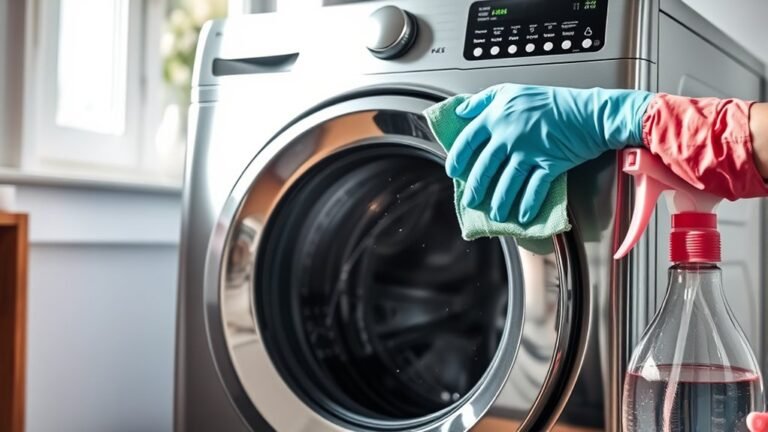How to Reduce Cleaning Costs in Dryer
To reduce your dryer cleaning costs, make sure you clean the lint filter after every load and wash it monthly to prevent buildup. Use dryer sheets sparingly to avoid residue, and consider switching to wool dryer balls—they speed drying and cut expenses. Don’t overload the dryer and regularly inspect vents and seals to catch issues early. Scheduling routine professional maintenance can also save repair costs. Keep these tips in practice, and you’ll discover even more ways to save on your dryer upkeep.
Regularly Clean the Lint Filter

Because a clogged lint filter restricts airflow and forces your dryer to work harder, you should clean it after every load. This simple step in lint filter maintenance not only prevents overheating but also enhances your dryer’s energy efficiency, saving you money on utility bills. After each cycle, remove the filter and clear away all lint buildup—don’t just glance over it. For a deeper clean, wash the filter with warm soapy water monthly to remove residue that diminishes airflow. Keeping your lint filter spotless reduces drying time, preserves your dryer’s lifespan, and cuts down on repair costs. By committing to this quick routine, you gain more control over your expenses and enjoy the freedom of a reliably efficient dryer.
Inspect and Clear the Dryer Vent
While you might keep the lint filter clean, neglecting the dryer vent can still lead to higher energy bills and potential safety hazards. To avoid costly repairs or fire risks, make it a habit to inspect and clear the dryer vent regularly. Vent blockage restricts airflow, forcing your dryer to work harder and consume more energy. Start by disconnecting the vent hose and checking for any debris or lint buildup. Use a vent brush or vacuum to remove obstructions thoroughly. Proper airflow maintenance not only improves drying efficiency but also extends your dryer’s lifespan. Taking these simple steps saves you money on utility bills and costly professional cleanings, giving you the freedom to enjoy your laundry routine without worry or extra expense.
Use Dryer Sheets Sparingly

You’ll want to use dryer sheets sparingly to avoid residue build-up that can clog your dryer and increase cleaning costs. Using fewer sheets not only keeps your machine running efficiently but also saves you money over time. Being mindful about this simple step helps maintain your dryer’s performance while cutting unnecessary expenses.
Benefits of Limited Use
Although dryer sheets can make your laundry smell fresh and reduce static, using them sparingly can help you cut down on cleaning costs. When you limit dryer sheet use, you reduce residue buildup inside the dryer, which means less frequent deep cleaning and longer appliance life. This approach pairs well with limited drying cycles, saving energy and lowering utility bills. Plus, you avoid clogging vents or filters, which can degrade dryer performance and increase maintenance expenses. By conserving energy and minimizing residue, you free yourself from costly repairs and replacements. So, choose to use dryer sheets only when necessary—this practical step supports your freedom from high cleaning costs while promoting efficient, energy-conscious drying. It’s a simple way to maintain your dryer’s health and your wallet’s well-being.
Preventing Residue Build-up
One key way to prevent residue build-up in your dryer is to use dryer sheets sparingly. Overusing them leads to residue that clogs vents and filters, increasing cleaning frequency and costs. For effective residue prevention, consider these practical cleaning techniques:
- Limit dryer sheet use to every few loads, not every cycle.
- Choose reusable wool dryer balls to reduce chemical residue.
- Regularly wipe drum surfaces to remove residue before it hardens.
- Clean lint filters after each use to avoid buildup.
- Ventilate your laundry area to prevent moisture and residue accumulation.
Cost-Effective Laundry Tips
Managing dryer sheet use not only helps prevent residue buildup but also cuts down on your overall laundry expenses. You don’t need to use a sheet with every load—try every other cycle or less, depending on your laundry organization system and fabric type. Overusing sheets can leave behind film that reduces dryer efficiency and leads to extra cleaning costs. Pair this with smart detergent selection: choose efficient, low-residue detergents that complement your dryer’s performance. Keeping your laundry area organized makes it easier to track sheet usage and detergent amounts, ensuring you’re not overspending or creating unnecessary buildup. By using dryer sheets sparingly and optimizing detergent use, you maintain your dryer’s longevity and enjoy more freedom from costly maintenance and frequent cleanings.
Avoid Overloading the Dryer

When you overload your dryer, it forces the machine to work harder and longer, which can increase energy use and wear out parts faster. To maintain drying efficiency and guarantee proper load balance, avoid stuffing too many clothes inside. A balanced load promotes even drying, reducing the need for extra cycles and expensive repairs. Here’s how you can keep your dryer running smoothly without overspending:
Overloading your dryer causes inefficiency and wear; keep loads balanced for optimal performance and energy savings.
- Sort laundry by fabric type and weight
- Fill the drum no more than three-quarters full
- Distribute clothes evenly around the drum
- Avoid mixing bulky items with small ones
- Check the drum’s movement before starting the cycle
Schedule Routine Professional Maintenance
Although regular cleaning helps, scheduling routine professional maintenance guarantees your dryer stays efficient and safe. A professional technician can spot potential issues early, keeping repair costs low and extending your dryer’s lifespan. Consider maintenance frequency based on usage: heavy use demands more frequent check-ups.
| Maintenance Frequency | Tasks Performed | Benefits |
|---|---|---|
| Every 6 months | Lint removal, vent check | Prevents fire hazards |
| Annually | Motor inspection | Improves energy efficiency |
| Every 2 years | Belt and drum check | Avoids breakdowns |
| As needed | Parts replacement | Saves costly repairs |
Sticking to this schedule frees you from unexpected expenses, giving you more control and fewer worries over your dryer’s performance.
Optimize Dryer Settings for Efficiency
You can cut down on cleaning costs by choosing the right drying cycle for each load, avoiding unnecessary wear on your dryer. Adjusting the temperature settings to match fabric types also helps prevent overheating and buildup. These simple tweaks keep your dryer running efficiently and reduce the need for frequent cleanings.
Select Appropriate Drying Cycles
Since drying cycles vary in duration and heat intensity, selecting the right one can considerably cut down energy use and wear on your clothes. To boost drying efficiency, you should match the cycle selection to the fabric type and load size. Using the correct cycle prevents over-drying, which saves energy and extends your dryer’s lifespan. Consider these tips:
- Use shorter cycles for small or lightly damp loads
- Choose delicate or low-heat cycles for sensitive fabrics
- Select heavy-duty cycles only for bulky, thick items
- Opt for moisture-sensor cycles when available to avoid unnecessary drying
- Avoid defaulting to “high heat” for every load
Adjust Temperature Settings
When aiming to reduce cleaning costs, adjusting your dryer’s temperature settings can make a significant difference. By optimizing temperature efficiency, you prevent overheating that leads to excess lint buildup and wear on dryer components. Lower energy settings not only save money but also extend the time between required cleanings. Start by selecting the lowest temperature suitable for the fabric type—this minimizes damage while ensuring effective drying. Avoid using high heat for delicate or synthetic materials, as it increases residue accumulation. Regularly check and fine-tune your dryer’s control panel to maintain ideal temperature levels. With consistent adjustments, you’ll enjoy better drying performance, reduced energy consumption, and fewer costly maintenance sessions. Taking control of your dryer’s temperature settings is a practical step toward freedom from frequent cleaning hassles.
Utilize Dryer Balls to Reduce Drying Time
Although it may seem like a small change, using dryer balls can considerably cut down your dryer’s run time. These simple tools improve drying efficiency by separating clothes, allowing hot air to circulate better. Beyond faster drying, dryer ball benefits include reducing static and softening fabrics naturally, saving you money on fabric softeners.
To maximize these benefits, keep these points in mind:
- Use 3-6 dryer balls per load for ideal airflow.
- Choose wool or rubber dryer balls for durability.
- Replace dryer balls every 1-2 years.
- Combine with lower temperature settings for energy savings.
- Avoid overloading the dryer to maintain efficiency.
Keep the Dryer Drum Clean
Regularly cleaning your dryer drum prevents residue buildup that can reduce drying efficiency and increase energy costs. To keep your dryer running smoothly, focus on consistent drum maintenance. Wipe the interior with a soft cloth dampened with mild cleaning products designed for appliances—avoid harsh chemicals that might damage the drum’s surface. Pay special attention to stubborn spots, using a non-abrasive sponge to gently lift residues. This simple routine not only improves drying performance but also extends your dryer’s lifespan, saving you from costly repairs or replacements. By investing a few minutes regularly, you maintain freedom from high energy bills and inconvenient breakdowns. Keeping the dryer drum clean is a smart, cost-conscious strategy that supports efficient, hassle-free laundry days.
Monitor and Repair Seals and Gaskets
You should inspect your dryer’s seals and gaskets regularly to catch wear and tear early. Look for cracks, tears, or hardening that can cause leaks and reduce efficiency. Deciding whether to repair or replace these parts promptly can save you money on energy and cleaning in the long run.
Seal Inspection Frequency
Inspecting seals and gaskets at least once a month can save you significant repair costs down the line. Regular checks help you catch early signs of seal damage before they escalate, ensuring your dryer runs efficiently and safely. Using simple inspection methods like visual examination and touch can quickly reveal cracks, wear, or misalignment. Here’s what you should focus on during your seal inspection:
- Look for cracks or brittle areas on seals and gaskets
- Check for gaps or misalignment that let air or moisture escape
- Feel for softness loss or hardening indicating material fatigue
- Inspect around edges for dirt build-up that hides damage
- Confirm seals fit snugly without warping or deformation
Sticking to this schedule keeps maintenance manageable and protects your freedom from costly downtime.
Common Gasket Issues
Common gasket issues often stem from wear and tear, exposure to heat, and moisture buildup, all of which can compromise your dryer’s efficiency and safety. Over time, gasket wear can cause air leaks, reducing drying performance and increasing energy costs. You’ll want to regularly inspect the seals for cracks, brittleness, or gaps. Catching these problems early helps you avoid more expensive repairs down the line. If you notice damage, a timely seal replacement is essential to maintain proper airflow and prevent lint accumulation inside the dryer. Staying vigilant about gasket condition not only extends your dryer’s lifespan but also keeps your energy bills in check. Taking these proactive steps empowers you to keep your dryer running smoothly with minimal cleaning costs.
Repair vs. Replacement
Keeping an eye on your dryer’s seals and gaskets means knowing when a repair will do and when replacement is the smarter choice. You want to balance repair costs with long-term savings, avoiding expensive breakdowns and frequent cleaning. Minor cracks or worn areas often justify repair, while extensive damage calls for replacement options.
Consider these factors when deciding:
- Age of the dryer and frequency of use
- Severity and location of gasket damage
- Cost comparison between repair parts and new seals
- Availability of replacement parts for your model
- Impact of leaks on cleaning frequency and energy efficiency
Implement Energy-Saving Practices
Although it might seem minor, implementing energy-saving practices can greatly cut your dryer’s cleaning costs by reducing wear and tear. Start by drying full loads to maximize energy efficiency, which lowers both power use and the frequency of cleaning needed. Use moisture sensor settings to avoid over-drying—this not only saves energy but also prevents lint buildup. Regularly clean the lint filter after every load to maintain peak airflow, reducing strain on your dryer. Consider air-drying lightweight items to lessen the dryer’s workload. These simple steps boost energy efficiency, leading to significant cost savings over time. By prioritizing these habits, you’ll extend your dryer’s lifespan and keep maintenance costs down, freeing you from unnecessary expenses and hassles.
Frequently Asked Questions
Can Using a Gas Dryer Reduce Cleaning Costs Compared to Electric Dryers?
Like finding a shortcut through a busy city, choosing a gas dryer can improve your gas efficiency and lower energy bills. While gas dryers often heat faster and use less energy than electric models, the cost comparison depends on your local utility rates. Cleaning costs might be slightly lower since gas dryers typically produce less lint buildup. So, if you’re looking to save money and enjoy efficient drying, gas dryers could be a smart choice.
How Does Hard Water Affect Dryer Cleanliness and Maintenance?
Hard water can cause mineral buildup in your dryer’s components, especially in the water reservoir if it has a steam function. This buildup reduces efficiency and increases maintenance needs, costing you more time and money. To keep your dryer running smoothly, you’ll want to regularly clean or descale parts exposed to hard water. Doing this prevents clogs and extends your dryer’s lifespan, giving you more freedom from frequent repairs and expenses.
Are There Eco-Friendly Dryer Cleaning Products That Are Effective?
You’ll find plenty of eco-friendly dryer cleaning products that actually work. Look for natural cleaners made from plant-based ingredients—they’re gentle yet effective. Biodegradable options break down quickly, so you’re protecting the environment while keeping your dryer clean. These products often cost less over time since they reduce wear and tear on your machine. Choosing them helps you save money and enjoy the freedom of a cleaner, greener home without harsh chemicals.
Can a Dryer Cause Mold Growth in the Laundry Room?
Yes, your dryer can contribute to mold growth in the laundry room if moisture isn’t properly controlled. To prevent this, focus on effective mold prevention by ensuring your dryer vents are clean and vented outside. Also, keep the laundry room well-ventilated to reduce humidity. Using a dehumidifier or opening windows helps maintain moisture control, protecting your space from mold and saving you costly repairs down the line.
Does the Age of the Dryer Influence Cleaning Frequency or Costs?
Yes, the age of your dryer definitely impacts how often you need to clean it and the costs involved. Older dryers may have a shorter dryer lifespan and can accumulate lint or debris faster, requiring more frequent maintenance. To keep expenses low, follow maintenance tips like regularly cleaning the lint trap, checking vents, and scheduling professional inspections. Staying proactive helps you save money and maintain your freedom from costly repairs or replacements.






